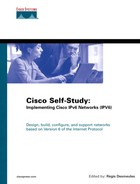Cisco IOS Software IPv6 Tools
This section covers the ping and traceroute tools, used as helpful diagnostic commands to basically validate connectivity with IPv6 destinations. This section also covers other tools used to manage the router, such as Telnet, SSH, TFTP, and the HTTP server on Cisco.
Using the Cisco IOS Software IPv6 ping Command
Troubleshooting support for IPv6 is available with the ping command. This command allows the sending of ICMPv6 echo request messages to an IPv6 destination node. For each ICMPv6 echo request message received, the destination responds using an ICMPv6 echo reply message. The absence of an ICMPv6 echo reply message can indicate a problem between sender and receiver nodes.
This command accepts a destination address or the host name as an argument. However, the address family IPv6 must be specified. Example 3-12 shows the use of the ping ipv6 command with a destination IPv6 address.
Example 3-12. ping ipv6 Command Sends ICMPv6 Echo Request Messages to an IPv6 Destination
RouterA#ping ? WORD Ping destination address or hostname ip IP echo ipv6 IPv6 echo srb srb echo tag Tag encapsulated IP echo <cr> RouterA#ping ipv6 2001:410:0:1:200:86ff:fe4b:f9ce Type escape sequence to abort. Sending 5, 100-byte ICMP Echos to 2001:410:0:1:200:86FF:FE4B:F9CE, timeout is 2 seconds: !!!!! Success rate is 100 percent (5/5), round-trip min/avg/max = 1/1/1 ms |
Using the Cisco IOS Software IPv6 traceroute Command
Troubleshooting support for IPv6 is also available with the traceroute command. It lets you trace the route to reach an IPv6 destination node. This command displays the list of intermediary routers up to the final destination.
This command accepts a destination address or the host name as an argument. However, the address family ipv6 must be specified. Example 3-13 shows the use of the traceroute ipv6 command with a destination IPv6 address.
Example 3-13. traceroute ipv6 Command Traces the Route to an IPv6 Destination
RouterA#traceroute ? WORD Trace route to destination address or hostname appletalk AppleTalk Trace clns ISO CLNS Trace ip IP Trace ipv6 IPv6 Trace ipx IPX Trace oldvines Vines Trace (Cisco) vines Vines Trace (Banyan) <cr> RouterA#traceroute ipv6 2001:410:0:1:200:86FF:FE4B:F9CE Type escape sequence to abort. Tracing the route to 2001:410:0:1:200:86FF:FE4B:F9CE 1 2001:410:0:1:200:86FF:FE4B:F9CE 0 msec * 0 msec |
Using Cisco IOS Software IPv6 Telnet
The Telnet application is mainly used to get connected to a system that can be reached remotely over an IP network. By default, a Telnet server is enabled on Cisco routers.
Telnet clients and servers both support IPv6 on the router. Therefore, it is possible to establish a Telnet session to a Cisco router using its IPv6 address. The command telnet accepts a destination address or the host name as an argument. However, when the host name is used, the IPv6 address is tried first, and then the IPv4 address, to make the connection. Example 3-14 shows Router A using Telnet to reach another router with its IPv6 address.
Example 3-14. Telnetting to a Router Using Its IPv6 Address
RouterA#telnet 2001:410:0:1:250:3EFF:FEE4:4C00
Trying 2001:410:0:1:250:3EFF:FEE4:4C00 ... Open
User Access Verification
Password:
|
Using Cisco IOS Software IPv6 Secure Shell (SSH)
SSH (Secure Shell) may be used in place of Telnet to access a remote system over an IP network. With Telnet, malicious users can sniff logins, passwords, and the content of a whole session on the network. SSH provides secure authentication and sessions.
Support for IPv6 has been added to the SSH client and server. SSH is available on Cisco IOS Software for both IPv4 and IPv6 with 3DES cryptographic software.
SSH Client with IPv6 Support
As with Telnet, the command ssh accepts a destination IPv6 address or the host name as an argument. The syntax is the same as the IPv4 command. However, when the host name is used, the IPv6 address is tried first, and then the IPv4 address, to make the connection. Following is the syntax of the ssh command:
Router#ssh [-l userid][-c {des | 3des}] [-o numberofpasswdprompts n] [-p portnum] {ipv6-address | hostname} [command]
SSH Server with IPv6 Support
The commands for the SSH server on Cisco IOS Software have been extended to support IPv6. The SSH server is supported on platforms using Cisco IOS Software with 3DES software. The command ip ssh {[timeout seconds] | [authentication-retries integer]} configures SSH control variables on the router.
show ip ssh displays the SSH server's version and configuration. show ssh displays the status of the connections on the SSH server.
Using Cisco IOS Software IPv6 TFTP
You may download and upload files between the router and a TFTP server over IPv6. The command tftp accepts a destination IPv6 address or the host name as an argument. However, when the host name is used, the IPv6 address is tried first, and then the IPv4 address, to make the connection.
Example 3-15 presents an example of a router using tftp with an IPv6 address to copy the configuration to the TFTP server 2001:410:0:1::10.
Example 3-15. TFTP to a TFTP Server Using an IPv6 Address
Router#copy running-config tftp Address or name of remote host []? 2001:410:0:1::10 Destination filename [router-config]? |
Enabling the HTTP Server with IPv6 Support on Cisco IOS Software
The ip http server command has been updated to accept both IPv4 and IPv6 addresses on the router. However, when the HTTP server is enabled, it is for both IPv4 and IPv6, because the Cisco IOS Software with IPv6 does not provide the configuration of a single protocol.
When enabling the HTTP server using ip http server, it is highly recommended to restrict access to the router by defining an IPv6 ACL.
